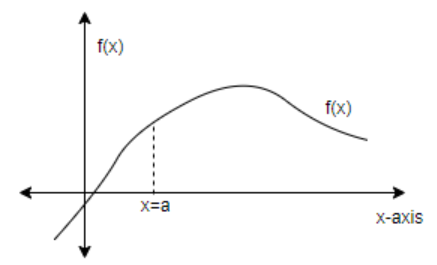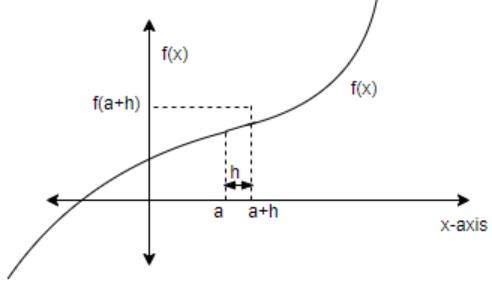
Prove the theorem: Let $f$ be a differentiable function in a nbd of a point $a$.
(i) If $f'\left( a \right)=0$ and $f'\left( x \right)>0$ in a deleted nbd of $a$ then $f$ is increasing at $a$.
Answer
564.3k+ views
Hint: We will start by using the conditions to be satisfied by a function which is differentiable at any point, when it is continuous at that point:
$\begin{align}
& f'\left( {{a}^{+}} \right)=\displaystyle \lim_{h \to 0}\dfrac{f\left( a+h \right)-f\left( a \right)}{h}=finite \\
& f'\left( {{a}^{-}} \right)=\displaystyle \lim_{h \to 0}\dfrac{f\left( a-h \right)-f\left( a \right)}{h}=finite \\
\end{align}$ , where $h \to positive$
$f'\left( {{a}^{+}} \right)=f'\left( {{a}^{-}} \right)=f'\left( a \right)=finite~~value$ , when the function is differentiable at point $a$.
Complete step-by-step solution
Since we have conditions given as $f'\left( x \right)>0$, we will apply this and form two equations for a positive and negative value of h. Then, we will use $f'\left( a \right)=0$ in the equation formed for the positive value of h to conclude the theorem.
Let $f$ is a function, which is continuous and differentiable in the neighborhood of point $a$ and at point $a$ also.

As we know that a function is differentiable at any point, when it is continuous at that point and following condition satisfies –
$\begin{align}
& f'\left( {{a}^{+}} \right)=\displaystyle \lim_{h \to 0}\dfrac{f\left( a+h \right)-f\left( a \right)}{h}=finite \\
& f'\left( {{a}^{-}} \right)=\displaystyle \lim_{h \to 0}\dfrac{f\left( a-h \right)-f\left( a \right)}{h}=finite \\
\end{align}$ , where $h \to positive$
And when $f'\left( {{a}^{+}} \right)=f'\left( {{a}^{-}} \right)=f'\left( a \right)=finite~~value$, then function is differentiable at point $a$.
According to definition of differentiability,
\[f'\left( a \right)=\displaystyle \lim_{h \to 0}\dfrac{f\left( a+h \right)-f\left( a \right)}{h}\] , where $h$ may be positive or negative both.
Now in theorem point $a$ is removed, means we cannot put value of $x$ as $a$ in given function $f\left( x \right)$.
So, let the curve of given function be $f\left( x \right)$. Given $f'\left( a \right)=0$ and $f'\left( x \right)>0$.
We know that, \[f'\left( a \right)=\displaystyle \lim_{h \to 0}\dfrac{f\left( a+h \right)-f\left( a \right)}{h}>0\] .
If we take $h$ as positive,
\[\Rightarrow \displaystyle \lim_{h \to 0}\dfrac{f\left( x+h \right)-f\left( x \right)}{h}>0\]
\[\Rightarrow f\left( x+h \right)-f\left( x \right)>0\]
\[\Rightarrow f\left( x+h \right)>f\left( x \right).......(i)\]
It means that if we increase the value of $x$, then value of function is also increasing.
Now, if we take $h$ as negative,
\[\Rightarrow \displaystyle \lim_{h \to 0}\dfrac{f\left( x+h \right)-f\left( x \right)}{h}>0\]
\[\Rightarrow f\left( x+h \right)-f\left( x \right)< 0\]
\[\Rightarrow f\left( x+h \right)< f\left( x \right).......(ii)\]
Here, $h$ is negative, means that if we decrease the value of $x$, then the value of function is also decreasing.
So, according to these relations, curve of given $f\left( x \right)$ will be –

Here, $f'\left( a \right)=0$
In equation (i), where $h>0$, put $x=a$ .
\[\begin{align}
& \Rightarrow f\left( x+h \right)>f\left( x \right) \\
& \Rightarrow f\left( a+h \right)>f\left( a \right) \\
\end{align}\]
So, in this function, if we increase $x$, then $f\left( x \right)$ will increase. So it is an increasing function.
Note: Let us take an example of \[f\left( x \right)={{x}^{3}}\]. This is differentiable in nbd of point $a=0$. We remove point $x=0$ from this.

\[f\left( x \right)={{x}^{3}}\]
We differentiate it with respect to $x$.
\[f'\left( x \right)=3{{x}^{2}}\], which is always positive except $x=0$. At $x=0,f'\left( x \right)=0$.
So, $f'\left( 0 \right)=0$, and $f'\left( x \right)>0$ for $x\in R-\left\{ 0 \right\}$.
Hence, \[f\left( x \right)={{x}^{3}}\] is an increasing function.
$\begin{align}
& f'\left( {{a}^{+}} \right)=\displaystyle \lim_{h \to 0}\dfrac{f\left( a+h \right)-f\left( a \right)}{h}=finite \\
& f'\left( {{a}^{-}} \right)=\displaystyle \lim_{h \to 0}\dfrac{f\left( a-h \right)-f\left( a \right)}{h}=finite \\
\end{align}$ , where $h \to positive$
$f'\left( {{a}^{+}} \right)=f'\left( {{a}^{-}} \right)=f'\left( a \right)=finite~~value$ , when the function is differentiable at point $a$.
Complete step-by-step solution
Since we have conditions given as $f'\left( x \right)>0$, we will apply this and form two equations for a positive and negative value of h. Then, we will use $f'\left( a \right)=0$ in the equation formed for the positive value of h to conclude the theorem.
Let $f$ is a function, which is continuous and differentiable in the neighborhood of point $a$ and at point $a$ also.

As we know that a function is differentiable at any point, when it is continuous at that point and following condition satisfies –
$\begin{align}
& f'\left( {{a}^{+}} \right)=\displaystyle \lim_{h \to 0}\dfrac{f\left( a+h \right)-f\left( a \right)}{h}=finite \\
& f'\left( {{a}^{-}} \right)=\displaystyle \lim_{h \to 0}\dfrac{f\left( a-h \right)-f\left( a \right)}{h}=finite \\
\end{align}$ , where $h \to positive$
And when $f'\left( {{a}^{+}} \right)=f'\left( {{a}^{-}} \right)=f'\left( a \right)=finite~~value$, then function is differentiable at point $a$.
According to definition of differentiability,
\[f'\left( a \right)=\displaystyle \lim_{h \to 0}\dfrac{f\left( a+h \right)-f\left( a \right)}{h}\] , where $h$ may be positive or negative both.
Now in theorem point $a$ is removed, means we cannot put value of $x$ as $a$ in given function $f\left( x \right)$.
So, let the curve of given function be $f\left( x \right)$. Given $f'\left( a \right)=0$ and $f'\left( x \right)>0$.
We know that, \[f'\left( a \right)=\displaystyle \lim_{h \to 0}\dfrac{f\left( a+h \right)-f\left( a \right)}{h}>0\] .
If we take $h$ as positive,
\[\Rightarrow \displaystyle \lim_{h \to 0}\dfrac{f\left( x+h \right)-f\left( x \right)}{h}>0\]
\[\Rightarrow f\left( x+h \right)-f\left( x \right)>0\]
\[\Rightarrow f\left( x+h \right)>f\left( x \right).......(i)\]
It means that if we increase the value of $x$, then value of function is also increasing.
Now, if we take $h$ as negative,
\[\Rightarrow \displaystyle \lim_{h \to 0}\dfrac{f\left( x+h \right)-f\left( x \right)}{h}>0\]
\[\Rightarrow f\left( x+h \right)-f\left( x \right)< 0\]
\[\Rightarrow f\left( x+h \right)< f\left( x \right).......(ii)\]
Here, $h$ is negative, means that if we decrease the value of $x$, then the value of function is also decreasing.
So, according to these relations, curve of given $f\left( x \right)$ will be –

Here, $f'\left( a \right)=0$
In equation (i), where $h>0$, put $x=a$ .
\[\begin{align}
& \Rightarrow f\left( x+h \right)>f\left( x \right) \\
& \Rightarrow f\left( a+h \right)>f\left( a \right) \\
\end{align}\]
So, in this function, if we increase $x$, then $f\left( x \right)$ will increase. So it is an increasing function.
Note: Let us take an example of \[f\left( x \right)={{x}^{3}}\]. This is differentiable in nbd of point $a=0$. We remove point $x=0$ from this.

\[f\left( x \right)={{x}^{3}}\]
We differentiate it with respect to $x$.
\[f'\left( x \right)=3{{x}^{2}}\], which is always positive except $x=0$. At $x=0,f'\left( x \right)=0$.
So, $f'\left( 0 \right)=0$, and $f'\left( x \right)>0$ for $x\in R-\left\{ 0 \right\}$.
Hence, \[f\left( x \right)={{x}^{3}}\] is an increasing function.
Recently Updated Pages
Master Class 12 English: Engaging Questions & Answers for Success

Master Class 12 Social Science: Engaging Questions & Answers for Success

Master Class 12 Chemistry: Engaging Questions & Answers for Success

India Manned Space Mission Launch Target Month and Year 2025 Update

Which of the following pairs is correct?

The Turko-Afghan rule in India lasted for about?

Trending doubts
What are the major means of transport Explain each class 12 social science CBSE

Which are the Top 10 Largest Countries of the World?

Draw a labelled sketch of the human eye class 12 physics CBSE

How much time does it take to bleed after eating p class 12 biology CBSE

Explain sex determination in humans with line diag class 12 biology CBSE

Plot a graph between potential difference V and current class 12 physics CBSE




